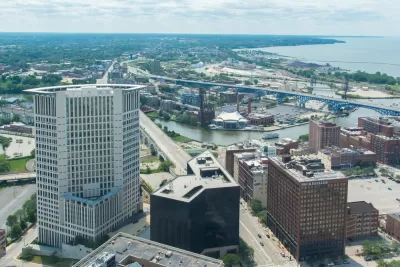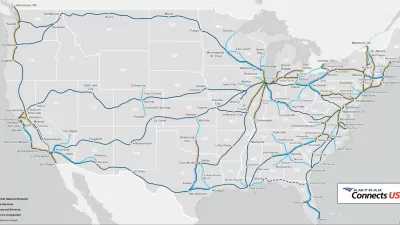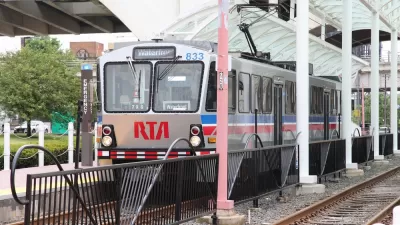Dual, cooperating studies are underway in Cleveland to reimagine the connections between the city's downtown and lakefront.

Cleveland recently launched a master planning process to revitalize its lakefront, when Mayor Justin Bibb announced a request for proposals for a $500,000 contract that builds on an earlier proposal made by the owners of the Cleveland Browns.
In an article for Cleveland.com, Steven Litt credits a May 2021 proposal by Jimmy and Dee Haslam for jumpstarting the conversation that led to the new master planning process, although there has been a long track record of revitalization plans proposed for linking Cleveland’s downtown core and the lakefront, such as a proposal for an intermodal transit facility picked up by Planetizen in October 2015. Downtown Cleveland and the Lake Erie waterfront are currently “separated by a bleak, 14-acre landscape of concrete and steel,” writes Litt.
“The Haslam concept sparked a $5 million transportation feasibility analysis, funded 50-50 by the city and the Ohio Department of Transportation, that started earlier this year. The feasibility study is aimed at clarifying the impact on local and regional traffic if the Shoreway were altered in order to enable the Mall extension,” adds Litt.
Mayor Bibb’s contract would expend the purview of the city’s studies beyond traffic impacts, however, and in a much larger portion of the city. “The new study area will extend from the Warehouse District on the west to East 18th Street on the east, and the city’s municipal parking lots along South Marginal Road,” writes Litt.
City officials hope to use the two studies in concert to pursue federal funding opportunities, through the Infrastructure Investment and Jobs Act, in 2024.

Trump Administration Could Effectively End Housing Voucher Program
Federal officials are eyeing major cuts to the Section 8 program that helps millions of low-income households pay rent.

Planetizen Federal Action Tracker
A weekly monitor of how Trump’s orders and actions are impacting planners and planning in America.

Ken Jennings Launches Transit Web Series
The Jeopardy champ wants you to ride public transit.

Washington Legislature Passes Rent Increase Cap
A bill that caps rent increases at 7 percent plus inflation is headed to the governor’s desk.

From Planning to Action: How LA County Is Rethinking Climate Resilience
Chief Sustainability Officer Rita Kampalath outlines the County’s shift from planning to implementation in its climate resilience efforts, emphasizing cross-departmental coordination, updated recovery strategies, and the need for flexible funding.

New Mexico Aging Department Commits to Helping Seniors Age ‘In Place’ and ‘Autonomously’ in New Draft Plan
As New Mexico’s population of seniors continues to grow, the state’s aging department is proposing expanded initiatives to help seniors maintain their autonomy while also supporting family caregivers.
Urban Design for Planners 1: Software Tools
This six-course series explores essential urban design concepts using open source software and equips planners with the tools they need to participate fully in the urban design process.
Planning for Universal Design
Learn the tools for implementing Universal Design in planning regulations.
Heyer Gruel & Associates PA
Ada County Highway District
Institute for Housing and Urban Development Studies (IHS)
City of Grandview
Harvard GSD Executive Education
Toledo-Lucas County Plan Commissions
Salt Lake City
NYU Wagner Graduate School of Public Service





























